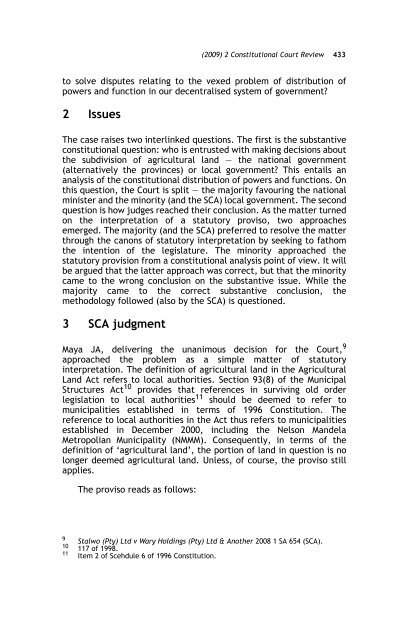The decision in Wary Holdings (Pty) - PULP
The decision in Wary Holdings (Pty) - PULP
The decision in Wary Holdings (Pty) - PULP
You also want an ePaper? Increase the reach of your titles
YUMPU automatically turns print PDFs into web optimized ePapers that Google loves.
(2009) 2 Constitutional Court Review 433<br />
to solve disputes relat<strong>in</strong>g to the vexed problem of distribution of<br />
powers and function <strong>in</strong> our decentralised system of government?<br />
2 Issues<br />
<strong>The</strong> case raises two <strong>in</strong>terl<strong>in</strong>ked questions. <strong>The</strong> first is the substantive<br />
constitutional question: who is entrusted with mak<strong>in</strong>g <strong>decision</strong>s about<br />
the subdivision of agricultural land — the national government<br />
(alternatively the prov<strong>in</strong>ces) or local government? This entails an<br />
analysis of the constitutional distribution of powers and functions. On<br />
this question, the Court is split — the majority favour<strong>in</strong>g the national<br />
m<strong>in</strong>ister and the m<strong>in</strong>ority (and the SCA) local government. <strong>The</strong> second<br />
question is how judges reached their conclusion. As the matter turned<br />
on the <strong>in</strong>terpretation of a statutory proviso, two approaches<br />
emerged. <strong>The</strong> majority (and the SCA) preferred to resolve the matter<br />
through the canons of statutory <strong>in</strong>terpretation by seek<strong>in</strong>g to fathom<br />
the <strong>in</strong>tention of the legislature. <strong>The</strong> m<strong>in</strong>ority approached the<br />
statutory provision from a constitutional analysis po<strong>in</strong>t of view. It will<br />
be argued that the latter approach was correct, but that the m<strong>in</strong>ority<br />
came to the wrong conclusion on the substantive issue. While the<br />
majority came to the correct substantive conclusion, the<br />
methodology followed (also by the SCA) is questioned.<br />
3 SCA judgment<br />
Maya JA, deliver<strong>in</strong>g the unanimous <strong>decision</strong> for the Court, 9<br />
approached the problem as a simple matter of statutory<br />
<strong>in</strong>terpretation. <strong>The</strong> def<strong>in</strong>ition of agricultural land <strong>in</strong> the Agricultural<br />
Land Act refers to local authorities. Section 93(8) of the Municipal<br />
Structures Act 10 provides that references <strong>in</strong> surviv<strong>in</strong>g old order<br />
legislation to local authorities 11 should be deemed to refer to<br />
municipalities established <strong>in</strong> terms of 1996 Constitution. <strong>The</strong><br />
reference to local authorities <strong>in</strong> the Act thus refers to municipalities<br />
established <strong>in</strong> December 2000, <strong>in</strong>clud<strong>in</strong>g the Nelson Mandela<br />
Metropolian Municipality (NMMM). Consequently, <strong>in</strong> terms of the<br />
def<strong>in</strong>ition of ‘agricultural land’, the portion of land <strong>in</strong> question is no<br />
longer deemed agricultural land. Unless, of course, the proviso still<br />
applies.<br />
<strong>The</strong> proviso reads as follows:<br />
9 Stalwo (<strong>Pty</strong>) Ltd v <strong>Wary</strong> Hold<strong>in</strong>gs (<strong>Pty</strong>) Ltd & Another 2008 1 SA 654 (SCA).<br />
10<br />
117 of 1998.<br />
11 Item 2 of Scehdule 6 of 1996 Constitution.

















